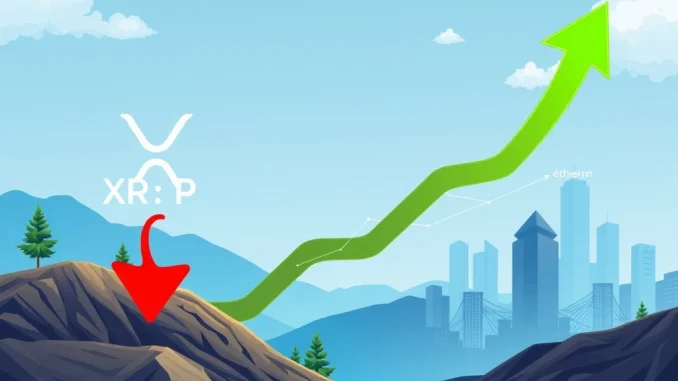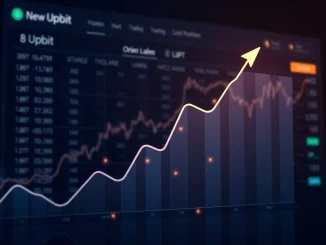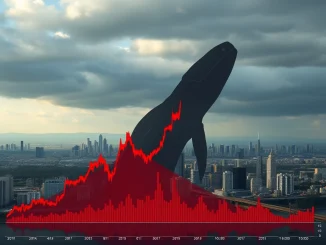
The cryptocurrency market is a dynamic landscape, constantly shifting with news, investor sentiment, and macroeconomic factors. Recently, the spotlight has been on two major players: XRP and Ethereum. While XRP experienced a notable price dip, deemed a ‘healthy correction’ by analysts, Ethereum has been celebrating significant gains driven by a surge in institutional adoption. Understanding these diverging trajectories is key to navigating today’s complex crypto environment.
XRP Price Correction: A Necessary Rebalancing Act?
The late July period saw the XRP price decline by 19%, dropping from a multiyear high of $3.66 to an intraday low of $2.95. This sharp correction, however, was quickly characterized by market analysts as a ‘healthy’ and necessary rebalancing. Why healthy? The primary reasons cited include:
- Liquidation of Over-Leveraged Positions: A significant portion of the decline was attributed to the unwinding of over-leveraged long positions. As prices began to dip, cascading liquidations amplified the downward pressure, clearing out speculative bets.
- Market Rebalancing: Post-ETF uncertainty has kept the broader crypto market on edge. A correction like this allows the market to digest recent gains, consolidate, and establish a more sustainable price floor.
- Long-Term Optimism: Despite the short-term pain, many experts remain optimistic about XRP’s long-term prospects, viewing this as a temporary setback rather than a fundamental shift in its value proposition.
This volatility is par for the course in the crypto world, particularly for altcoins that often exhibit higher beta to market movements. While the immediate impact on XRP holders was felt, the underlying sentiment suggests that such corrections are integral to the asset’s maturation.
Ether Gains: Riding the Wave of Institutional Adoption
In stark contrast to XRP’s correctional phase, Ethereum has been experiencing a powerful surge, largely fueled by escalating institutional adoption. A standout example is Bitcoin mining firm BitMine Immersion Technologies, which acquired over $2.03 billion worth of ETH in just 16 days. This aggressive accumulation underscores a significant trend:
- Strategic Staking Play: Led by FundStrat’s Tom Lee, BitMine aims to stake 5% of the total ETH supply. This move is not merely speculative; it’s a strategic long-term play to stabilize Ethereum’s supply by reducing circulating ETH, thereby supporting potential price appreciation through scarcity.
- Confidence in Ethereum’s Staking Potential: The sheer volume of BitMine’s purchase signals growing institutional confidence in Ethereum’s staking rewards and the robust security of its network, especially post-Merge.
- Supply Shock Concerns: This aggressive buying spree has naturally triggered concerns about a potential supply shock, where demand outstrips available supply, leading to significant price increases.
Michael Novogratz of Galaxy Digital has even predicted that Ether could outperform Bitcoin in the next six months, potentially reaching $4,000. This bullish outlook is rooted in Ethereum’s evolving fundamentals and its increasing appeal to large-scale investors looking for yield and long-term growth.
Crypto Volatility: Navigating the Broader Market Landscape
The individual trajectories of XRP and Ethereum unfold against a backdrop of broader crypto volatility. The crypto sector’s total market cap recently dipped to $3.79 trillion, reflecting a general market sensitivity to macroeconomic signals. The week saw significant liquidations:
- Bitcoin dipped below $116,000, triggering $585.86 million in long liquidations.
- Ether similarly saw $104.76 million in open positions liquidated.
These figures highlight the sector’s exposure to sudden macro shifts and the inherent risks of leveraged positions. However, it’s not all downward pressure. Some altcoins, like Conflux (CFX) and Ethena (ENA), defied the trend with gains exceeding 40%, illustrating the diverse performance within the market.
The interplay between global M2 liquidity trends and crypto asset prices is also a recurring theme. Eric Trump’s assertion that Ether “should be over $8K” as M2 hits record highs adds to the narrative that expanding liquidity could fuel risk-on sentiment across markets, including crypto. While such predictions remain speculative, they underscore the optimistic outlook many have for crypto’s future, especially for assets with strong fundamentals and growing utility.
What Does This Mean for Investors? Actionable Insights
The contrasting performances of XRP and Ethereum offer valuable lessons for investors navigating the crypto market:
- Diversification is Key: Relying on a single asset can expose investors to significant risk. A diversified portfolio can help mitigate the impact of individual asset corrections.
- Understand the ‘Why’ Behind Price Movements: Distinguish between a ‘healthy correction’ driven by market mechanics (like XRP’s recent dip) and fundamental shifts in an asset’s value.
- Monitor Institutional Flow: The influx of institutional capital, particularly into assets like Ethereum for staking, signals strong long-term confidence and can be a powerful catalyst for price appreciation.
- Be Wary of Leverage: The recent liquidations across Bitcoin and Ether serve as a stark reminder of the dangers of over-leveraged positions in a volatile market.
- Long-Term Vision: While short-term fluctuations are inevitable, focusing on assets with strong technological foundations, growing adoption, and clear use cases often yields better results in the long run.
In conclusion, the crypto market continues to evolve at a rapid pace. While XRP’s recent correction serves as a reminder of market volatility and the importance of rebalancing, Ethereum’s impressive gains, driven by substantial institutional adoption, highlight the growing maturity and strategic importance of certain digital assets. As market participants continue to balance short-term corrections with long-term structural trends in adoption and supply management, the landscape remains ripe with opportunities for informed investors.
Frequently Asked Questions (FAQs)
Q1: Why was XRP’s 19% price drop considered a ‘healthy correction’?
A1: Analysts viewed XRP’s 19% drop as a healthy correction primarily because it flushed out over-leveraged long positions and allowed for a necessary rebalancing of the market. This process can help establish a more stable and sustainable price floor by removing speculative excess.
Q2: How is institutional adoption impacting Ethereum’s price?
A2: Institutional adoption, exemplified by firms like BitMine Immersion Technologies acquiring billions in ETH for staking, is significantly boosting Ethereum’s price. This creates a potential supply shock by reducing circulating ETH, signaling strong confidence in its long-term value, and attracting more large-scale investments.
Q3: What are the main differences in market dynamics between XRP and Ether currently?
A3: Currently, XRP is navigating volatility and regulatory scrutiny, leading to short-term corrections and liquidity challenges. Ether, on the other hand, is experiencing strong upward momentum driven by institutional demand for staking, its energy efficiency post-Merge, and predictions of outperforming Bitcoin.
Q4: What role does M2 liquidity play in crypto market predictions?
A4: Global M2 liquidity, which measures the total money supply, is often seen as a macro indicator that can fuel ‘risk-on’ sentiment in markets, including crypto. When M2 liquidity expands, some analysts and figures, like Eric Trump, suggest it could lead to higher valuations for risk assets like Ether, though such predictions remain speculative.
Q5: What are some key takeaways for investors from the recent crypto market movements?
A5: Key takeaways include the importance of diversification, understanding the reasons behind price movements (e.g., healthy corrections vs. fundamental shifts), monitoring institutional capital flows, avoiding excessive leverage, and maintaining a long-term investment perspective on assets with strong fundamentals.



